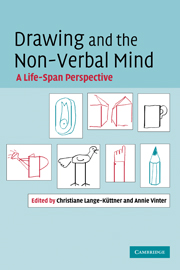Book contents
- Frontmatter
- Contents
- Contributors
- 1 Contemporary enquiries into a long-standing domain: Drawing research
- Part I Self, symbols and intention
- 2 Understanding reflections of self and other objects
- 3 Drawing production, drawing re-experience and drawing re-cognition
- 4 Style and other factors affecting children's recognition of their own drawings
- 5 Children's understanding of the dual nature of pictures
- 6 Pictorial intention, action and interpretation
- Part 2 Syntax, space systems and projection
- Part III Aging, blindness and autism
- Index
- References
4 - Style and other factors affecting children's recognition of their own drawings
Published online by Cambridge University Press: 22 September 2009
- Frontmatter
- Contents
- Contributors
- 1 Contemporary enquiries into a long-standing domain: Drawing research
- Part I Self, symbols and intention
- 2 Understanding reflections of self and other objects
- 3 Drawing production, drawing re-experience and drawing re-cognition
- 4 Style and other factors affecting children's recognition of their own drawings
- 5 Children's understanding of the dual nature of pictures
- 6 Pictorial intention, action and interpretation
- Part 2 Syntax, space systems and projection
- Part III Aging, blindness and autism
- Index
- References
Summary
Previous research suggests that 4-year-old children can recognize their own drawings after significant delay. Five possible bases for such recognition are identified by Campbell et al. Two of these, recognition of personal drawing style and recollection of the drawing episode, are perhaps available to most 4-year-olds capable of drawing objects. A preliminary study shows that most children of that age have a distinctive personal drawing style. Three studies explore the developing ability to recognize drawings after a one-month delay, and refine methods for studying this achievement, at individual and group level. These studies show little success at group level until late in the fifth year. However, at the individual level, the proportion of children demonstrating recognition ability increases steadily throughout the fifth year, and even some young 4-year-olds show competence. The contributions of the factors of style and episodic memory in achieving this ability remain elusive. However, it is argued that the task is a promising one for studying these developing aspects of self-knowledge.
the age at which children can reliably recognize their own drawings was investigated around thirty years ago by Stacey and Ross (1975), and a few years later by Nolan, Adams and Kagan (1980), and Nolan and Kagan (1980, 1981). Five-year-old children recognized their own drawings without difficulty after delays of a week or more (five weeks in one of Stacey and Ross's conditions). The position with younger children was less clear.
- Type
- Chapter
- Information
- Drawing and the Non-Verbal MindA Life-Span Perspective, pp. 63 - 85Publisher: Cambridge University PressPrint publication year: 2008



